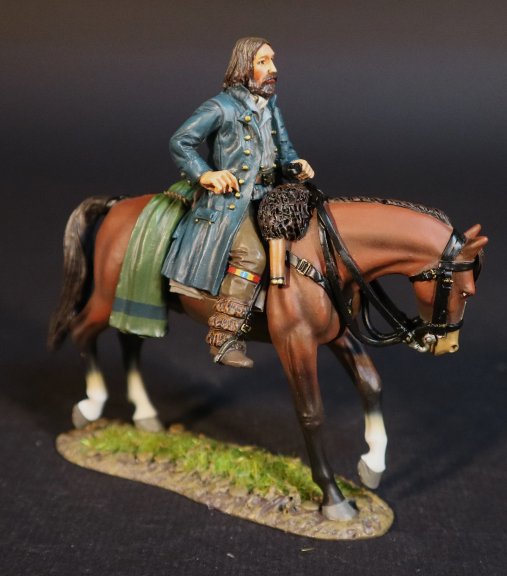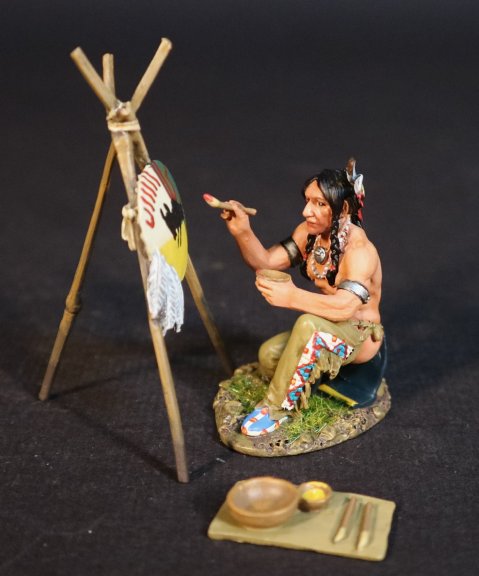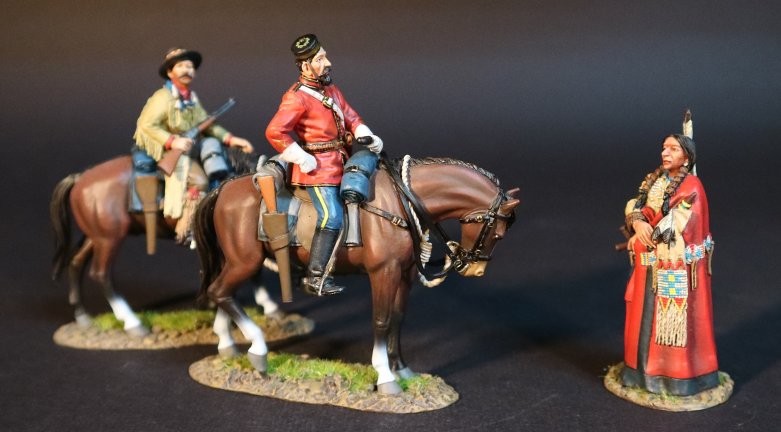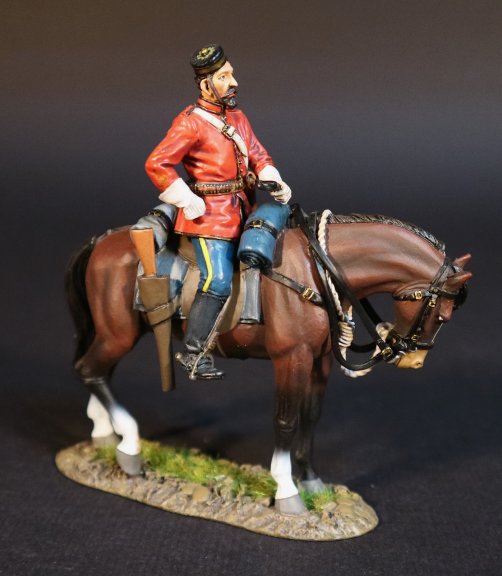- Joined
- Feb 2, 2011
- Messages
- 2,093
NEW RELEASES FOR FEBRUARY 2024
THE FUR TRADE
MOUNTAIN MEN - THE RENDEZVOUS
A mountain man was an explorer who lived in the wilderness. They were instrumental in opening up the various Emigrant Trails (widened into wagon roads) allowing Americans in the east to settle the new territories of the far west by organized wagon trains traveling over roads explored and in many cases, physically improved by the mountain men and the big fur companies originally to serve the mule train based inland fur trade.
Mountain men were most common in the North American Rocky Mountains from about 1810 through to the 1880s (with a peak population in the early 1840s). Approximately 3,000 mountain men ranged the mountains between 1820 and 1840, the peak beaver-harvesting period. While there were many free trappers, most mountain men were employed by major fur companies. The life of a company man was almost militarized. The men had mess groups, hunted and trapped in brigades and always reported to the head of the trapping party.
This man was called a "boosway", a bastardization of the French term bourgeois. He was the leader of the brigade and the head trader.

MAJOR ANDREW HENRY
Major Andrew Henry (c. 1775-January 10[SUP]th[/SUP], 1832) was an American miner, army officer, frontiersman, trapper and entrepreneur.
Alongside William H. Ashley, Henry was the co-owner of the successful Rocky Mountain Fur Company, otherwise known as “Ashley’s Hundred”, for the famous mountain men working for their firm from 1822 to 1832.
He is depicted by John Huston in the 1971 film “Man in The Wilderness”, and by Domhnall Gleeson in the 2015 film “The Revenant”, both of which depict Hugh Glass’s bear attack and journey.

WSP-40
THE FUR TRADE,
THE MOUNTAIN MEN,
MAJOR ANDREW HENRY

WSP-36
THE FUR TRADE,
THE SHIELD PAINTER.
(3 pcs)
The War shield was one of the most important pieces of the warrior’s paraphernalia.
Although it could be punctured by a direct blow, a shield struck at an angle was tough enough to deflect lances, arrows or even a smoothbore ball at mid-range. It was considered a most sacred and potent possession. Its painted symbols and the items appended to it had resulted from a vision, and in its manufacture and care the warrior bestowed intense selectivity, craftsmanship and thought.
The decoration and painting of the shield was always accompanied by special ceremonies conducted by medicine men and proven warriors.
A common Sioux practice was for the warrior to sit before the holy man and recount his coups with small sticks, dropping one for each coup, while the holy man painted on designs, prayed over them and sang war songs to affix their power permanently. These services were considered to be worth as many as two fine horses.
THE NORTH WEST MOUNTED POLICE
THE MARCH WEST
The NWMP was established by the Canadian government during the ministry of Prime Minister Sir John Macdonald who defined its purpose as “the preservation of peace and the prevention of crime” in the vast NWT.
Macdonald’s principal fear was that the activities of American traders which led to the Cypress Hills Massacre would lead to the First nations peoples killing American traders, which would lead to the United States military being deployed into the NWT to protect the lives of American citizens under the grounds that Canada was unable to maintain law and order in the region.
His greatest fear was that if the Americans occupied the NWT that they would not leave and the region would be annexed to the United States.

The NWMP was established in 1873, and were deployed to the area of the present Alberta border.
Their ill-planned and arduous journey of nearly 900 miles became known as the March West, and is portrayed as an epic journey of endurance.
Over the next few years, the NWMP established a wide network of forts, posts and patrols and extended Canadian law across the region. The living conditions of the NWMP on the prairies were spartan and often uncomfortable, and only slowly improved over the course of the century.
James Morrow Walsh (22 May 1840 – 25 July 1905)
Born in Prescott, Ontario, James Walsh was one of the original officers of the NWMP. Superintendent Walsh was assigned in 1875 to establish a post in the Cypress Hills in what is now Saskatchewan. The post was located here because of the 1873 massacre, an atrocity stemming from the illegal American whisky trade.

WSP-81
THE FUR TRADE,
THE NORTH WEST MOUNTED POLICE,
SUPERINTENDENT (MAJOR) JAMES MORROW WALSH 1877.
(2pcs)
(RCMP USED UNDER LICENCE)
Walsh’s original role was to shut down this trade, but in June 1876 his position grew in importance when several thousand Sioux crossed the border into Canada, taking refuge there after the Battle of Little Big Horn.
Walsh developed a strong friendship with the famous Sioux leader Sitting Bull, and successfully kept peace in the region. Walsh became famous in the American press as “Sitting Bull’s Boss”.
In reality Walsh’s orders were to convince Sitting Bull and the Sioux to return to the United States, but the Canadian government decided that Walsh’s friendship with Sitting Bull was an obstacle to the Sioux’s return across the border.
In 1880 Walsh was transferred to Fort Qu’Appelle, Saskatchewan, and soon after he reluctantly resigned his commission.
In August 1897 during the height of the Klondike Gold Rush, Walsh was appointed Commissioner of the newly created Yukon Territory. He resigned in 1898, returning to Ontario where he died in 1905.
Mount Walsh a mountain peak in the Saint Elias Mountains in the Yukon is named after him.
For those interested in learning more about James Morrow Walsh and Sitting Bull, Ian Anderson’s book “Sitting Bull’s Boss, Above the Medicine Line with James Morrow Walsh” is recommended.
ISBN 1-895811-63-5
**PLEASE CONTACT YOUR LOCAL DEALER FOR FURTHER INFORMATION**
THE FUR TRADE
MOUNTAIN MEN - THE RENDEZVOUS
A mountain man was an explorer who lived in the wilderness. They were instrumental in opening up the various Emigrant Trails (widened into wagon roads) allowing Americans in the east to settle the new territories of the far west by organized wagon trains traveling over roads explored and in many cases, physically improved by the mountain men and the big fur companies originally to serve the mule train based inland fur trade.
Mountain men were most common in the North American Rocky Mountains from about 1810 through to the 1880s (with a peak population in the early 1840s). Approximately 3,000 mountain men ranged the mountains between 1820 and 1840, the peak beaver-harvesting period. While there were many free trappers, most mountain men were employed by major fur companies. The life of a company man was almost militarized. The men had mess groups, hunted and trapped in brigades and always reported to the head of the trapping party.
This man was called a "boosway", a bastardization of the French term bourgeois. He was the leader of the brigade and the head trader.

MAJOR ANDREW HENRY
Major Andrew Henry (c. 1775-January 10[SUP]th[/SUP], 1832) was an American miner, army officer, frontiersman, trapper and entrepreneur.
Alongside William H. Ashley, Henry was the co-owner of the successful Rocky Mountain Fur Company, otherwise known as “Ashley’s Hundred”, for the famous mountain men working for their firm from 1822 to 1832.
He is depicted by John Huston in the 1971 film “Man in The Wilderness”, and by Domhnall Gleeson in the 2015 film “The Revenant”, both of which depict Hugh Glass’s bear attack and journey.

WSP-40
THE FUR TRADE,
THE MOUNTAIN MEN,
MAJOR ANDREW HENRY

WSP-36
THE FUR TRADE,
THE SHIELD PAINTER.
(3 pcs)
The War shield was one of the most important pieces of the warrior’s paraphernalia.
Although it could be punctured by a direct blow, a shield struck at an angle was tough enough to deflect lances, arrows or even a smoothbore ball at mid-range. It was considered a most sacred and potent possession. Its painted symbols and the items appended to it had resulted from a vision, and in its manufacture and care the warrior bestowed intense selectivity, craftsmanship and thought.
The decoration and painting of the shield was always accompanied by special ceremonies conducted by medicine men and proven warriors.
A common Sioux practice was for the warrior to sit before the holy man and recount his coups with small sticks, dropping one for each coup, while the holy man painted on designs, prayed over them and sang war songs to affix their power permanently. These services were considered to be worth as many as two fine horses.
THE NORTH WEST MOUNTED POLICE
THE MARCH WEST
The NWMP was established by the Canadian government during the ministry of Prime Minister Sir John Macdonald who defined its purpose as “the preservation of peace and the prevention of crime” in the vast NWT.
Macdonald’s principal fear was that the activities of American traders which led to the Cypress Hills Massacre would lead to the First nations peoples killing American traders, which would lead to the United States military being deployed into the NWT to protect the lives of American citizens under the grounds that Canada was unable to maintain law and order in the region.
His greatest fear was that if the Americans occupied the NWT that they would not leave and the region would be annexed to the United States.

The NWMP was established in 1873, and were deployed to the area of the present Alberta border.
Their ill-planned and arduous journey of nearly 900 miles became known as the March West, and is portrayed as an epic journey of endurance.
Over the next few years, the NWMP established a wide network of forts, posts and patrols and extended Canadian law across the region. The living conditions of the NWMP on the prairies were spartan and often uncomfortable, and only slowly improved over the course of the century.
James Morrow Walsh (22 May 1840 – 25 July 1905)
Born in Prescott, Ontario, James Walsh was one of the original officers of the NWMP. Superintendent Walsh was assigned in 1875 to establish a post in the Cypress Hills in what is now Saskatchewan. The post was located here because of the 1873 massacre, an atrocity stemming from the illegal American whisky trade.

WSP-81
THE FUR TRADE,
THE NORTH WEST MOUNTED POLICE,
SUPERINTENDENT (MAJOR) JAMES MORROW WALSH 1877.
(2pcs)
(RCMP USED UNDER LICENCE)
Walsh’s original role was to shut down this trade, but in June 1876 his position grew in importance when several thousand Sioux crossed the border into Canada, taking refuge there after the Battle of Little Big Horn.
Walsh developed a strong friendship with the famous Sioux leader Sitting Bull, and successfully kept peace in the region. Walsh became famous in the American press as “Sitting Bull’s Boss”.
In reality Walsh’s orders were to convince Sitting Bull and the Sioux to return to the United States, but the Canadian government decided that Walsh’s friendship with Sitting Bull was an obstacle to the Sioux’s return across the border.
In 1880 Walsh was transferred to Fort Qu’Appelle, Saskatchewan, and soon after he reluctantly resigned his commission.
In August 1897 during the height of the Klondike Gold Rush, Walsh was appointed Commissioner of the newly created Yukon Territory. He resigned in 1898, returning to Ontario where he died in 1905.
Mount Walsh a mountain peak in the Saint Elias Mountains in the Yukon is named after him.
For those interested in learning more about James Morrow Walsh and Sitting Bull, Ian Anderson’s book “Sitting Bull’s Boss, Above the Medicine Line with James Morrow Walsh” is recommended.
ISBN 1-895811-63-5
**PLEASE CONTACT YOUR LOCAL DEALER FOR FURTHER INFORMATION**

